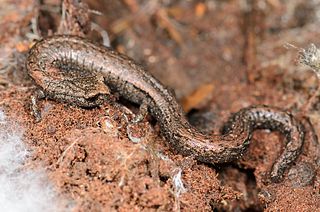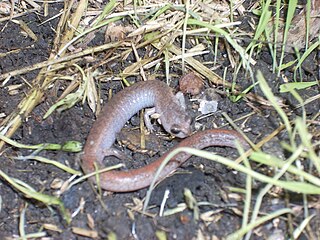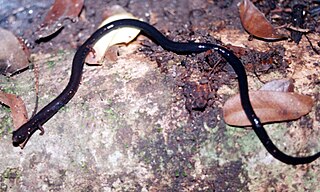| Image | Common Name | Scientific name | Year described | Distribution |
|---|
| Greenhorn Mountains slender salamander | Batrachoseps altasierrae | Jockusch et al., 2012 | Kern and Tulare counties, California, USA |
 | California slender salamander | Batrachoseps attenuatus | Eschscholtz, 1833 | Sierra Nevada, California, and northern Central Valley of California, and southwestern Oregon. |
| Fairview slender salamander | Batrachoseps bramei | Jockusch, et al., 2012 | California |
| Inyo Mountains slender salamander | Batrachoseps campi | Marlow, Brode & Wake, 1979 | Inyo County of eastern California |
| Hell Hollow slender salamander | Batrachoseps diabolicus | Jockusch, Wake & Yanev, 1998 | California, in Mariposa County |
 | San Gabriel slender salamander | Batrachoseps gabrieli | Wake, 1996 | San Gabriel Mountains of Los Angeles County, California |
 | Gabilan Mountains slender salamander | Batrachoseps gavilanensis | Jockusch, Yanev & Wake, 2001 | Central Coast region from Santa Cruz to northern Kern County, California |
 | Gregarious slender salamander | Batrachoseps gregarius | Jockusch, Wake & Yanev, 1998 | western Sierra Nevada and the eastern Central Valley in California |
| San Simeon slender salamander | Batrachoseps incognitus | Jockusch, Yanev & Wake, 2001 | south-western Monterey and northern San Luis Obispo Counties, California |
 | Sequoia slender salamander | Batrachoseps kawia | Jockusch, Wake & Yanev, 1998 | Tulare County, California |
 | San Lucia Mountains slender salamander | Batrachoseps luciae | Jockusch, Yanev & Wake, 2001 | Monterey County, California |
 | Garden slender salamander | Batrachoseps major | Camp, 1915 | northern Baja California in Mexico and Southern California, United States |
| Lesser slender salamander | Batrachoseps minor | Jockusch, Yanev & Wake, 1998 | San Luis Obispo County, California |
 | Black-bellied slender salamander | Batrachoseps nigriventris | Cope, 1869 | California. |
 | Pacific slender salamander | Batrachoseps pacificus | (Cope, 1865) | Channel Islands of California. |
| King's River slender salamander | Batrachoseps regius | Jockusch, Wake & Yanev, 1998 | Fresno County, California. |
| Relictual slender salamander | Batrachoseps relictus | Brame & Murray, 1968 | Kern County, California. |
| Kern Plateau slender salamander | Batrachoseps robustus | Wake, Yanev & Hansen, 2002 | Tulare and Inyo, and Kern Counties, California. |
| Kern Canyon slender salamander | Batrachoseps simatus | Brame & Murray, 1968 | Kern Counties, California. |
| Tehachapi slender salamander | Batrachoseps stebbinsi | Brame & Murray, 1968 | Kern Counties, California. |
| Arguello slender salamander | Batrachoseps wakei | Sweet & Jockusch, 2021 | Santa Barbara County, California |
 | Oregon slender salamander | Batrachoseps wrighti | (Bishop, 1937) | Oregon, |
|























